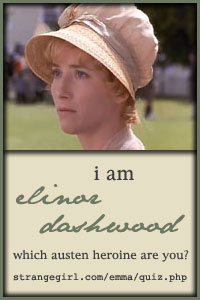
Tuesday, March 31, 2009
Masterpiece Theatre: David Copperfield

Friday, March 27, 2009
On Re-Reading

Monday, March 23, 2009
Lack of Posts Explained

Tuesday, March 17, 2009
Weekly Geek: Worst Movie Adaptations
Weekly Geek 2009-10
Worst movie adaptations: The recent release of Watchmen based on the graphic novel by Alan Moore got me thinking about what I thought were the worst movie adaptations of books. What book or books did a director or directors completely ruin in the adaptation(s) that you wish you could "unsee," and why in your opinion, what made it or them so bad in contrast to the book or books?
Okay, I try to be forgiving when it comes to adaptations of books. You can't simply slap scenes from the page onto the screens. Cinematic art requires that stories be interpreted and changed to fit the new medium. However, I do feel that the essence of the story and the author's feelings on certain subjects should remain intact. Here is the film that I feel did the worst job in translating its story from book to screen.
The Chronicles of Narnia: Prince Caspian
By the time I got around to seeing Prince Caspian, my expectations were already kind of low. I had lots of misgivings about the first film, The Lion, the Witch, and the Wardrobe, and the reviews that I was reading on the Internet were not all that great. I was willing to give it a shot, however, and I REALLY tried to go into it with an open mind. By the end, I wanted to throw something at the TV. C. S. Lewis is one of my favorite authors, and though I'll grant that Prince Caspian is probably the weakest book in The Chronicles, it still deserved a better interpretation than this. Here are some of the problems:
- Characterization: I barely recognized any of the main characters. Caspian was WAY too old and had WAY too much confidence in himself. Peter was not the natural leader of the book, but rather a spoiled teenager with a power complex who needed a kick in the pants. Susan "The Gentle" became Susan "Warrior Princess". And Aslan was nowhere to be found. The only characters that remotely resembled their book counterparts were Lucy and Edmund.
- Themes: Lewis' main themes in Prince Caspian are loyalty and authority. Throughout the novel, everyone, including Caspian, looks to Peter and follows his lead. Susan is constantly being told to "obey the High King" and Trumpkin tells Caspian that he will take his orders, even though he does not agree with him. These themes are completely lost in the movie. Caspian and Peter are in a constant power struggle when there should not have been one, and Trumpkin is never shown to have actually disagreed with Caspian, making his obedience less powerful.
- Lord of the Rings Rip-offs: There are so many things that Andrew Adamson stole from The Lord of the Rings movies that Peter Jackson should sue him. Trees that walk and defeat the enemy (they are actually dryads in the book), the ground splitting open during the final battle, Susan throwing arrows ala Legolas, the list goes on and on. Don't believe me? Here's the clincher: in The Fellowship of the Ring, Boromir has the following line, "This isn't a mine. It's a tomb!". In Prince Caspian, Peter has the following line, "This isn't a fortress. It's a tomb!". You're right, I was just imagining similarities.
I'm not saying that you can't enjoy this film. There are many people who can, like my younger sister. I just know that, as someone who loves Lewis' original creations, I find adaptations like these to be detrimental to the stories. It is especially depressing when I hear a young person say how much they love the stories, and yet have never actually picked up the books. They don't know what they are missing.
How about you? Is there a film adaptation of one of your favorites that you wish could be destroyed and forgotten?
Friday, March 13, 2009
Kim

Monday, March 9, 2009
Explore New Worlds
Tuesday, March 3, 2009
The Posthumous Papers of the Pickwick Club

Monday, March 2, 2009
Happy Birthday To:

















